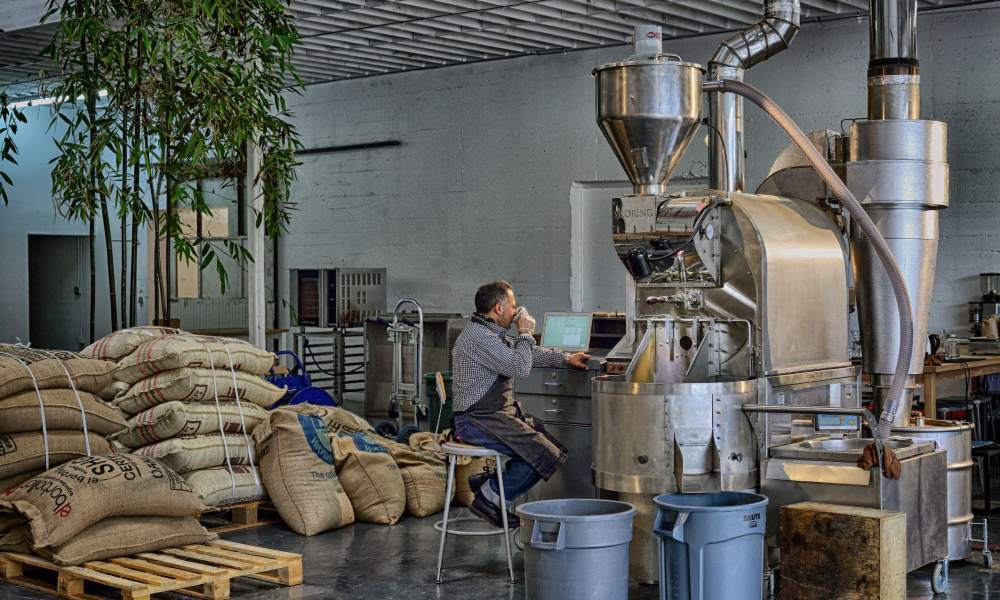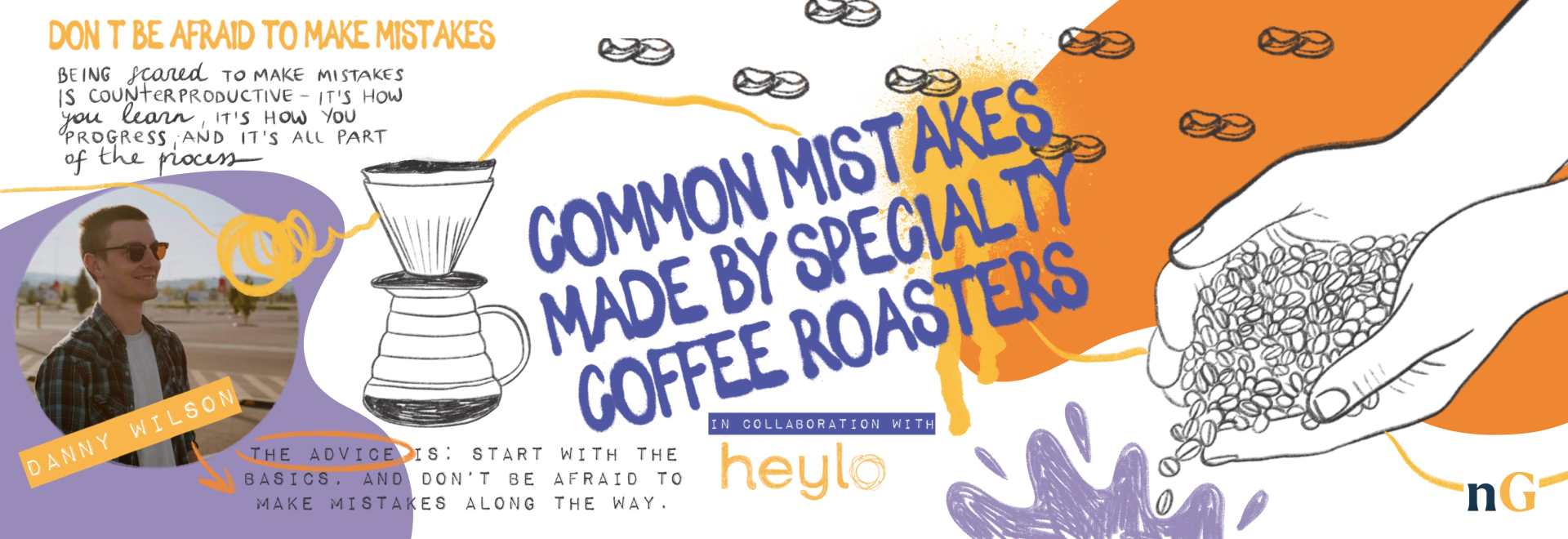Common mistakes made by specialty coffee roasters
Jordan Montgomery and Danny Wilson speak about common mistakes made by specialty coffee roasters in the second article of the series, #SpecialtyCoffeeMistakers
This article is the second in a series exploring the prevailing attitude towards mistakes in the specialty coffee sector. The series is being produced in collaboration with Heylo Coffee, who are eager to kickstart a conversation around “mistakes” – beginning on a road to normalising them.
In the specialty coffee sector, there is a culture of meticulousness and striving for excellence. In some instances, this can lead to an air of perfectionism, where mistakes are looked down upon. This can put undue pressure on many actors across the industry, creating unnecessary stress.
Heylo is seeking to reverse this narrative: Mistakes do happen; and embracing them could foster a more open, healthy, and constructive environment.
This collaborative series will look at common mistakes made by baristas, coffee roasters, and coffee shop owners – not in an effort to expose people working in those roles; but to embrace failure as part of the process, and as part of life.
Mistakes made by specialty coffee roasters
Starting and operating a business can be a daunting prospect – and it’s no surprise that there are innumerable obstacles and challenges lying in wait, ready to trip you up.
Beyond the more general difficulties associated with running a business, specialty coffee roasters must face the added complexity of variations between coffee harvests and a particularly volatile commodity price which – while many will be trading above this – invariably affects the entire industry.
With these continuously shifting parameters, managing the finances of a specialty coffee roaster could be considered a constant uphill battle.
This can be made worse when a new business has spent ambitiously at the outset – for example, spending too much money on expensive coffee and equipment.
“Always start small with your equipment – not only are smaller roasting machines going to be a smaller initial investment, but if you are still learning how to roast or developing your roast style, then a lower capacity roaster will mean that you end up roasting more batches,” says Danny Wilson, head roaster at Ona Coffee.
“Roasting more small batches gives you more opportunity to practise your skills, lower costs if you make a mistake and if you blend many small batches together into an overall more consistent product.”
Roasting in small batches is certainly a good strategy for those just starting out. However, coffee is a difficult product to work with in more ways than one.
Many roasters also have difficulty managing their stock levels. Although there are programs designed to assist roasters with such tasks, Danny believes each business should create a system suitable for their specific needs – especially when buying multiple lots and coffee origins.
“It’s important to understand that naming conventions like farm, process and producer will always need to adapt depending on the coffees you buy,” he says. “Different origins will follow different naming conventions and the more coffees you buy the more complicated this becomes, especially if you start buying multiple similar but distinct lots from the same producer.”
“Finally you should have a good understanding of how weight-loss of different roasting styles, samples taken for QC, and general wastage affects how much green coffee turns into finished bags on the shelf.”
Indeed, an average of 16% of the weight of coffee is lost during the roasting process. Beyond recognising this and properly accounting for it, specialty coffee roasters need a level of technical prowess to effectively manage this loss.

No strangers to the grind
Understanding how different coffee origins, varieties and processing methods will behave during the process takes years to master, and there are numerous shifting variables.
Yet, there is an expectation that each bag of specialty coffee will be as perfect as the last. However, coffee is a natural product – it is not uniform, it changes over time, and there are innumerable external factors that affect it; it seems, therefore, as though specialty coffee roasters do something similar to turning lemons into lemonade.
“Every day there are so many different variables you are always trying to keep track of – from environmental factors like temperature and humidity, different roasting approaches and different requirements from coffees – that the last thing you need is to introduce more chaos with poor organisation and planning,” says Danny.
“As a roaster, you should build consistency and routine into everything you do from warm-up procedures, roast tracking and maintenance as all can have a significant impact on cup quality.”
Implementing these protocols can also help to minimise wastage and improve the efficiency of your roastery. In Australia alone, the coffee sector generates over 65,000 tonnes of waste annually. Additionally, these protocols serve as a valuable resource to fall back on when the roastery team begins to get tired.
Specialty coffee roasters are no strangers to the grind – both literally and figuratively. The hours can be long, and the work physically demanding. This can create a situation where mistakes are more likely, such as inadequate between-batch protocols, under or overloading roast batches, or baking and scorching the beans.
In the moment, these mistakes can feel like the end of the world; particularly when you are dealing with specialty coffee – where each lot represents the hard work and dedication of farmers.
And while roasters should certainly treat their coffees with care and respect, being scared to make mistakes is counterproductive – it’s how you learn, it’s how you progress, and it’s all part of the process.
Don’t be afraid to make mistakes
Having navigated the roasting process where there may have already been a number of close encounters with mistakes, much of the danger actually lies after the roast is finished. How specialty coffee roasters market and share their products is crucial – now more than ever.
Finding the right avenues to sell coffee is becoming vital in today’s digital world, especially given the prevalence of social media and ecommerce in the sales landscape. Choosing which platforms to use can be difficult and can feel like an overwhelming decision.
“Most roasting businesses, especially when starting out, rely on returning or repeat customers,” Danny says. “These may be wholesale customers such as cafes or through retail sales to home baristas. Whichever platform you decide to work with should facilitate not only reaching new customers, but make return business as simple as possible.”
As a part of this, specialty coffee roasters must understand their customer base if they hope to engage them – online and off. Without this, they essentially don’t know who they are selling their coffee to, or what this mystery group enjoys.
“The modern specialty coffee market is flooded with a plethora of wildly different processing styles and flavour profiles,” Danny says.
“Understanding where your customers’ preferences and limits are with these flavours is crucial. Spending big on an experimental lot that is a little too extreme for your customers’ tastes is the easiest way to blow a huge hole in your green coffee budget.”
As such, while this may not be the most glamorous task of being a specialty coffee roaster, conducting thorough market research will help ensure your product lands with the right audience.
This shouldn’t deter anyone from producing exotic coffees. If that’s your passion, find a way to do it.
“Start safe, build trust and familiarity with your customers and your coffee offering, then you can test out more exotic options in small batches using special releases or promotions.”
As with many things, the advice is: start with the basics, and don’t be afraid to make mistakes along the way.
New Ground Coffee
Want to read more articles like this? Sign up for our newsletter!








